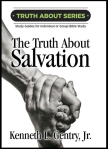MESSIAH AND ISRAEL’S “RETURN”
PMW 2023-091 by Kenneth L. Gentry, Jr.
Isa. 43:5–7 is a glorious prophecy. It reads:
“Fear not: for I am with thee: I will bring thy seed from the east, and gather thee from the west; I will say to the north, Give up; and to the south, Keep not back: bring my sons from far, and my daughters from the ends of the earth; Even every one that is called by my name: for I have created him for my glory, I have formed him; yea, I have made him.”
Despite initial appearances, these verses do not refer solely to Israel’s return from the Babylonian dispersion. Rather they refer beyond historic Israel to spiritual Israel gathered out from the nations through the worldwide spread of the gospel (Psa. 22:27–28; Isa. 2:2–4; Matt. 28:18–20; John 12:32; 1 Cor. 15:24–26). Isaiah is looking beyond the Babylonian exile to ultimate eschatological issues. Israel’s return from exile was an historical event that served as a typological pointer to worldwide redemption.
Four issues undermine any singular focus on the Babylonian return here:
(1) He does not say he will bring Israel “back” to the land (cf. Zech. 8:8; 10:6, 9, 10; Jer. 23:3; 8:37; 32:37).
(2) The four cardinal directions point beyond Babylon, which was northeast of Israel. This ultimately promises that Christ’s church will be brought together from all over the world (vv. 6b–8; cp. Matt. 8:11–12; John 11:52; Rom. 3:29; 1 John 2:2).

Van Til Conference on Eschatology (3 mp3 lectures)
Three formal lectures on various aspects of postmillennialsm.
An excellent introduction to postmillennialism from a distinctly Reformed perspective. Includes discussion of the leading objections to the postmillennial hope
as well as an application of Van Til’s apologetic method to the postmillennial argument.
See more study materials at: www.KennethGentry.com
(3) “The Servant,” who is so prominent in the larger surrounding section of Isaiah, is the Messiah. He comes to draw all men to himself (Matt. 28:18–20; John 10:16; 12:32; Eph. 2:13–18); but he is rejected by Israel (Matt. 23:37; John 1:11; 7:45–52; 8:39–59, 10:22–4219:14–15; Acts 4:10–11; 13:45–47; 18:6; 19:9; 22:21; 26:20).
(4) God speaks of Israel’s “offspring” (Heb., zara, “seed,” v. 5), which involves the church, which is “Abraham’s seed” (Gal. 3:7, 29; cp. Rom. 4:13, 18), the “Israel of God” (Gal. 6:16).
We need to read this passage in its literary context. It is found as a key statement in Isaiah 42:1–53:12. This major twelve-chapter section of Isaiah points out the gracious means by which God’s will is to be accomplished in the earth. Herein we find the four “Servant Songs” (see 42:1–9; 49:1–6; 50:4–9; 52:13–53:12). The “servant” concept speaks of one closely related to God and who is faithfully engaged in his service. For instance, we see this in “servant” references regarding Moses (Exo. 14:31; Num. 12:7; Deut. 34:5; Josh. 1:1–2; 9:24; Neh. 1:7; Dan. 9:11), David (2 Sam. 7:5, 26; 1 Kgs. 3:6; 8:25; Isa. 37:35; Jer. 23:21–22; Eze. 34:23–24; 37:24), and Isaiah (Isa. 20:3).
 The Truth about Salvation By Ken Gentry
The Truth about Salvation By Ken Gentry
A study guide for personal or small group Bible study. Deals with the Christian doctrine of salvation from a Reformed theological perspective. It opens with a study of God as loving Creator, the shows how the first man fell into sin. Shows God’s righteousness requires that sin be dealt with. Presents Jesus as both God and man so that he can be man’s Savior. Includes review questions and questions for further study.Twelve chapters are ideal for one quarter of Sunday School.
See more study materials at: www.KennethGentry.com
In Isaiah’s songs the Servant is both a corporate figure and an individual person, though the “Servant’s” first appearance in Isaiah is corporate (41:8). That is, it speaks of the nation of Israel ideally conceived (49:3; cp. 41:8; 43:10; 44:1, 2, 21; 45:4; 48:20) and the Messiah-Redeemer personally considered (42:1; 49:5–7; 53:1–5, 11). In the corporate sense “My servant” is flawed, being spiritually blind and deaf (42:19). In the personal sense, this prophecy is fulfilled in Jesus (Matt. 12:18–21; 1 Pet. 2:21–25). Isaiah always speaks of him in the present tense (42:1) or as already operating (49:1; 50:4; 53:2) because of Christ’s pre-existence (Mic. 5:2; John 1:1; 8:58; 17:5; 1 Cor 8:6; Col. 1:17; Heb. 1:10).
Kenneth L. Gentry Jr.'s Blog
- Kenneth L. Gentry Jr.'s profile
- 85 followers



